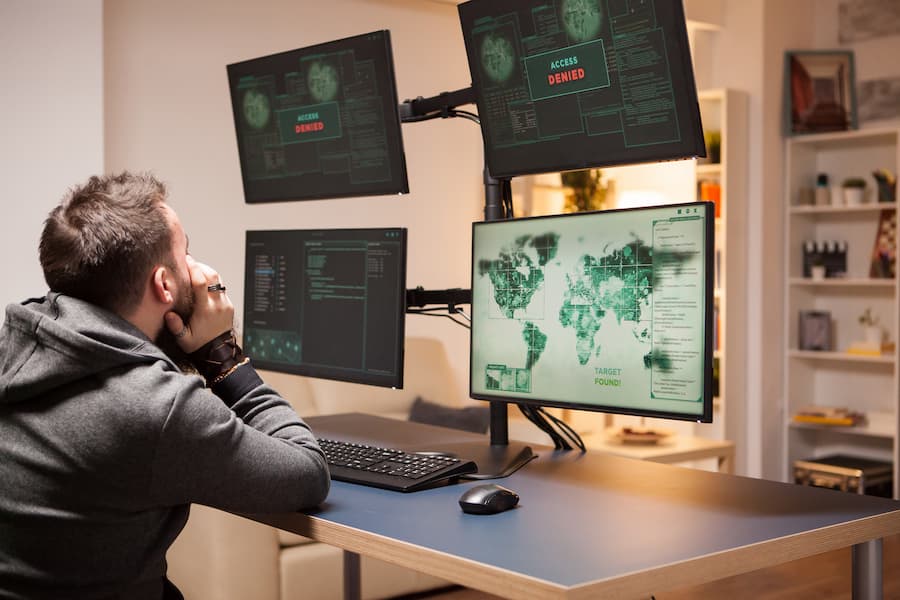The Future of Automated Threat Detection in Cybersecurity
Automated Threat Detection
Automated threat detection in cybersecurity represents a significant advancement in how organizations identify and respond to cyber threats. As cyber threats become more sophisticated and frequent, traditional manual methods of threat detection are no longer sufficient. Automated systems, powered by artificial intelligence (AI) and machine learning, provide a proactive and efficient approach to safeguarding sensitive data and maintaining robust security measures.
This article explores the future of automated threat detection, its components, benefits, applications, and the role of AI-driven technologies in enhancing cybersecurity.

The Evolution of Threat Detection
The journey of threat detection has evolved from basic antivirus software to advanced automated systems capable of real-time threat identification. Initially, threat detection relied heavily on signature-based methods, where known threats were identified based on predefined signatures. However, as cyber threats evolved, these methods proved inadequate in detecting new and unknown threats.
The shift towards automated threat detection marked a significant leap forward. Automation allowed for continuous monitoring and analysis of network traffic and endpoint activities, significantly reducing the time it takes to identify and respond to threats. Modern automated threat detection systems leverage AI and machine learning to analyze vast amounts of data, recognize patterns, and detect anomalies that may indicate a cyber threat.
How Automated Threat Detection Works
Automated threat detection systems operate by continuously monitoring network traffic, endpoint activities, and user behaviors to identify potential threats. These systems use a combination of AI algorithms and machine learning models to detect anomalies and suspicious activities that deviate from normal behavior patterns.
AI and machine learning play a crucial role in enhancing the capabilities of these systems. Machine learning models are trained on vast datasets of known threats and benign activities, enabling them to distinguish between legitimate and malicious actions. As these models are exposed to more data, they continuously improve their accuracy in detecting threats.
For example, an automated threat detection system might use machine learning to identify unusual login patterns, such as a user accessing the system from an unfamiliar location or at an odd hour. These anomalies are flagged for further investigation, allowing security teams to respond promptly to potential threats.
Components of an Automated Threat Detection System
An automated threat detection system comprises several key components that work together to provide comprehensive security coverage. These components include:
- Endpoint Security: This involves protecting individual devices such as computers, mobile devices, and servers. Endpoint security solutions monitor and analyze activities on these devices to detect and prevent malicious actions.
- Network Security: Network security focuses on monitoring and securing data as it travels across the network. It involves the use of firewalls, intrusion detection systems (IDS), and intrusion prevention systems (IPS) to identify and block suspicious network traffic.
- Threat Intelligence: Threat intelligence involves gathering and analyzing information about current and emerging threats. AI-driven threat intelligence platforms aggregate data from various sources, providing insights into the latest attack vectors and tactics used by cybercriminals.
- Security Operations Center (SOC): A SOC is a centralized unit that oversees and manages an organization’s security operations. It plays a critical role in monitoring, detecting, and responding to security incidents.
- Detection Systems: These systems use advanced algorithms and machine learning models to analyze data and identify potential threats. They can detect anomalies in network traffic, user behavior, and system activities.
- Automated Response: Automated response capabilities allow the system to take predefined actions when a threat is detected. This may include isolating affected devices, blocking malicious traffic, and alerting security teams for further investigation.
Benefits of Automated Threat Detection
Automated threat detection offers several benefits that enhance an organization’s overall security posture:
- Enhanced Accuracy and Speed: Automated systems can analyze vast amounts of data in real-time, allowing for quick identification of threats. This reduces the time it takes to detect and respond to security incidents, minimizing potential damage.
- Reduction in False Positives: Traditional threat detection methods often generate numerous false positives, overwhelming security teams. Automated systems, powered by AI and machine learning, can accurately distinguish between legitimate and malicious activities, reducing false positives and improving efficiency.
- Cost Savings: Automation reduces the need for manual monitoring and analysis, leading to cost savings in terms of labor and resources. It also minimizes the impact of security breaches, preventing costly data loss and reputational damage.
- Scalability: Automated threat detection systems can scale to handle large and complex environments, making them suitable for organizations of all sizes. They can adapt to changing threat landscapes and evolving security needs.
AI-Driven Threat Intelligence
AI-driven threat intelligence enhances the ability to detect and respond to cyber threats by providing valuable insights into the latest attack vectors and tactics. AI models analyze data from various sources, such as threat feeds, security logs, and historical incident data, to identify patterns and trends.
These insights enable security teams to stay ahead of emerging threats and implement proactive measures to protect their networks and endpoints. AI-driven threat intelligence platforms can also automate the correlation and analysis of threat data, reducing the time it takes to detect and respond to threats.
For example, an AI-driven threat intelligence platform might identify a new type of malware spreading rapidly across the internet. By analyzing the characteristics and behavior of this malware, the platform can generate signatures and detection rules, which are then distributed to automated threat detection systems for real-time protection.
Applications of AI in Threat Detection
AI has numerous applications in threat detection, enhancing the ability to identify and respond to cyber threats across various industries. Some key applications include:

- Anomaly Detection: AI models can identify unusual patterns and behaviors that may indicate a cyber threat. This includes detecting deviations in network traffic, user activities, and system performance.
- Behavioral Analysis: AI-driven systems can analyze user behaviors to detect suspicious activities. For example, if an employee suddenly accesses a large number of sensitive files, the system can flag this behavior for further investigation.
- Malware Detection: AI models can analyze the characteristics and behavior of files to identify malicious code. This allows for the detection of new and unknown malware that may bypass traditional signature-based detection methods.
- Threat Hunting: AI-powered threat hunting involves proactively searching for potential threats within an organization’s network. AI models can analyze historical data and identify indicators of compromise (IOCs) to uncover hidden threats.
- Incident Response Automation: AI-driven systems can automate response actions, such as isolating affected devices, blocking malicious traffic, and notifying security teams. This reduces response times and minimizes the impact of security incidents.
Challenges and Limitations of Automated Threat Detection
While automated threat detection offers significant benefits, it also comes with challenges and limitations:
- False Negatives: Despite advancements in AI and machine learning, automated systems may still miss certain threats, leading to false negatives. Continuous monitoring and updates are necessary to improve detection accuracy.
- Ethical and Privacy Concerns: The use of AI in threat detection raises ethical and privacy concerns. Organizations must ensure that their automated systems comply with privacy regulations and do not infringe on individual rights.
- Complexity and Cost: Implementing and maintaining automated threat detection systems can be complex and costly. Organizations need to invest in skilled personnel, infrastructure, and ongoing training to maximize the effectiveness of these systems.
- Adversarial Attacks: Cybercriminals are continually developing new techniques to evade automated detection systems. Adversarial attacks, where attackers manipulate data to deceive AI models, pose a significant challenge to automated threat detection.
By understanding these challenges and limitations, organizations can develop strategies to mitigate risks and maximize the benefits of automated threat detection systems.
Best Practices for Implementing Automated Threat Detection
Implementing automated threat detection effectively requires a structured approach to ensure optimal performance and integration within an organization’s existing cybersecurity framework. Here are some best practices to consider:
Conduct a Comprehensive Security Assessment
- Before implementing automated threat detection, conduct a thorough security assessment to understand the current threat landscape and identify vulnerabilities.
- Evaluate existing security measures and determine areas that would benefit from automation.
Define Clear Objectives and Requirements
- Establish clear objectives for what the automated threat detection system should achieve.
- Define specific requirements based on the organization’s size, industry, and threat profile.
Choose the Right Solution
- Select an automated threat detection solution that aligns with the organization’s needs and integrates seamlessly with existing security infrastructure.
- Consider solutions that offer scalability and flexibility to adapt to future needs.
Integrate with Security Operations Center (SOC)
- Ensure the automated threat detection system is integrated with the SOC for centralized monitoring and response.
- Implement processes for continuous monitoring and real-time alerting.
Regularly Update and Train AI Models
- Keep AI models and algorithms updated with the latest threat intelligence to enhance detection accuracy.
- Provide ongoing training for security personnel to effectively manage and utilize the automated system.
Continuous Monitoring and Improvement
- Implement a process for continuous monitoring and improvement of the automated threat detection system.
- Regularly review system performance, address any issues, and make necessary adjustments.
Enhancing Security Posture with Automated Threat Detection

Automated threat detection plays a crucial role in enhancing an organization’s overall security posture. Here are strategies to maximize its benefits:
Proactive Threat Hunting
- Utilize automated systems for proactive threat hunting to identify potential threats before they cause harm.
- Leverage AI and machine learning to analyze historical data and detect patterns indicative of malicious activity.
Integration with Other Cybersecurity Solutions
- Integrate automated threat detection with other cybersecurity solutions, such as endpoint protection, firewalls, and intrusion prevention systems (IPS).
- This integration provides a comprehensive security framework capable of addressing various threat vectors.
Implement Real-Time Threat Intelligence
- Use real-time threat intelligence to stay informed about the latest cyber threats and attack methods.
- Automated threat detection systems can incorporate this intelligence to enhance their detection capabilities.
Strengthen Incident Response Capabilities
- Develop robust incident response plans that leverage automated detection and response capabilities.
- Ensure that automated systems can quickly isolate affected devices, block malicious traffic, and alert security teams.
The Role of Incident Response in Automated Threat Detection
Incident response is a critical component of any automated threat detection strategy. Effective incident response ensures timely mitigation of threats and minimizes potential damage. Here’s how automated threat detection enhances incident response:
Automated Incident Detection and Response
- Automated systems can detect incidents in real-time and initiate predefined response actions without human intervention.
- This includes isolating affected systems, blocking malicious traffic, and notifying security teams.
Streamlined Incident Management
- Automated threat detection systems provide detailed incident reports and logs, aiding in the investigation and management of security incidents.
- These reports help security teams understand the nature of the threat and take appropriate actions.
Continuous Learning and Improvement
- Incident response processes should be continuously refined based on insights gained from automated threat detection systems.
- AI models can learn from past incidents to improve future detection and response accuracy.
Future Trends in Automated Threat Detection
The field of automated threat detection is rapidly evolving, with new technologies and innovations emerging regularly. Here are some future trends to watch:
Advanced AI and Machine Learning
- AI and machine learning will continue to evolve, providing even more sophisticated threat detection capabilities.
- Expect advancements in AI algorithms that can detect increasingly complex and subtle threats.
Integration of Behavioral Analysis
- Future systems will incorporate advanced behavioral analysis to identify abnormal user and system behaviors indicative of threats.
- This approach enhances the ability to detect insider threats and targeted attacks.
Increased Focus on Threat Intelligence Sharing
- Organizations will increasingly collaborate on threat intelligence sharing, leveraging collective knowledge to enhance automated detection systems.
- This collaboration helps stay ahead of emerging threats and reduces the risk of attacks.
Use of Predictive Analytics
- Predictive analytics will play a larger role in threat detection, allowing systems to anticipate and mitigate threats before they occur.
- This proactive approach reduces the window of opportunity for attackers.
What People May Also Ask
What is automated threat detection?
Automated threat detection uses advanced technologies such as AI and machine learning to identify and respond to cyber threats in real-time without human intervention.
How does AI enhance threat detection capabilities?
AI enhances threat detection by analyzing vast amounts of data to identify patterns and anomalies that may indicate a threat. Machine learning models continuously improve their accuracy by learning from new data.
What are the benefits of using AI-driven threat detection systems?
Benefits include faster detection and response times, reduced false positives, cost savings, and improved scalability. AI-driven systems can analyze data in real-time, providing proactive protection against threats.
How can businesses implement automated threat detection?
Businesses should conduct a security assessment, define clear objectives, choose the right solution, integrate with their SOC, regularly update AI models, and continuously monitor and improve the system.
What are the limitations of automated threat detection?
Limitations include potential false negatives, ethical and privacy concerns, complexity and cost of implementation, and the risk of adversarial attacks that deceive AI models.
Key Takeaways on Automated Threat DetectionConclusion
Automated threat detection represents the future of cybersecurity, offering advanced capabilities to protect organizations against evolving cyber threats. By implementing best practices, integrating with other security solutions, and leveraging AI-driven threat intelligence, organizations can significantly enhance their security posture.
As technology continues to advance, automated threat detection systems will become even more sophisticated, providing robust protection against the ever-changing threat landscape.
You can contact us by phone, email, or by visiting our offices:
- Phone: (386) 261-8323
- Email: contact@smarttechfl.com
- Address: 771 Fentress Blvd. #10, Daytona Beach, FL 32114












